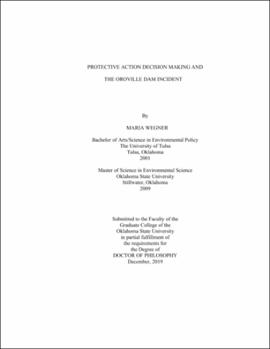| dc.contributor.advisor | Wu, Tristan | |
| dc.contributor.author | Wegner, Maria | |
| dc.date.accessioned | 2020-06-26T21:27:58Z | |
| dc.date.available | 2020-06-26T21:27:58Z | |
| dc.date.issued | 2019-12 | |
| dc.identifier.uri | https://hdl.handle.net/11244/324883 | |
| dc.description.abstract | Water resources infrastructure, including dams, provide significant benefits to the United States, but infrastructure also come with risks. Managing infrastructure risk requires an understanding of evacuation decision making including, how and when people evacuate, and what factors contribute and influence decisions to evacuate. Research to date primarily focuses on hurricane evacuation decision making. This study seeks to identify the factors that best explain warning diffusion, protective action initiation delay time, and protective action initiation and what people did during protective action delay time using data collected after the Oroville Dam incident in 2017. A time phased model of protective action decision making was applied to the study sample, which included two at-risk populations downstream of Oroville Dam: Population A, which includes households in Butte County, and Population B, which includes households in Sutter and Yuba Counties. The study found that distance from the dam was a factor in believing the spillway would break and their town and home would flood in Population A. Most demographic characteristics did not reflect decision making. However, income predicted warning receipt time and protective action initiation time in Population B. Income, as well as risk belief, risk perception, decision-making, distance, and warning receipt time predicted evacuation in Population A. Race, message believability, and decision-making predicted evacuation in Population B. In both Population A and Population B warning receipt time predicted protective action initiation time, which suggests that delays in issuing warning and warning diffusion rates delay evacuation. Message believability also predicted protective action initiation time in Population B. In Populations A and B, people sought additional information using a cell phone call; the primary sources for information were friends, relatives, neighbors, and co-workers. Both populations took time to pack items to take with prior to evacuating. The findings of this study will assist emergency managers, infrastructure managers, and government officials to better understand protective action decision making and improve evacuation rates, which in turn can save lives. | |
| dc.format | application/pdf | |
| dc.language | en_US | |
| dc.rights | Copyright is held by the author who has granted the Oklahoma State University Library the non-exclusive right to share this material in its institutional repository. Contact Digital Library Services at lib-dls@okstate.edu or 405-744-9161 for the permission policy on the use, reproduction or distribution of this material. | |
| dc.title | Protective action decision making and the Oroville Dam incident | |
| dc.contributor.committeeMember | Murphy, Haley | |
| dc.contributor.committeeMember | Chang, Ray | |
| dc.contributor.committeeMember | Wells, Tony | |
| osu.filename | Wegner_okstate_0664D_16525.pdf | |
| osu.accesstype | Open Access | |
| dc.type.genre | Dissertation | |
| dc.type.material | Text | |
| dc.subject.keywords | evacuation | |
| dc.subject.keywords | protective action decision making | |
| dc.subject.keywords | protective action initiation | |
| dc.subject.keywords | time phased model of protective action decision making | |
| dc.subject.keywords | time phased model of warning and response | |
| thesis.degree.discipline | Fire and Emergency Management Administration | |
| thesis.degree.grantor | Oklahoma State University | |
